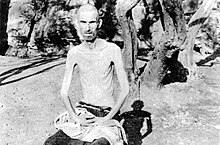Italian war crimes in Yugoslavia
The Italian war crimes in Yugoslavia were actions by the Italian armed forces during World War II in violation of international war and international law.
history
After German and Italian units attacked Yugoslavia in April 1941 , partisans and other resistance groups immediately formed there , against which German and Italian armed forces proceeded with extreme brutality. In the Slovenian and Croatian occupation areas of the 2nd Italian Army, the Italian military leadership carried out a racially-based colonization policy on the orders and with sustained support of the fascist regime . Mindful of the earlier Venetian rule in Istria and Dalmatia and in view of the Italian population group, which was concentrated there in the cities and had dominated the economy and trade for centuries , the fascist regime had tried since the 1920s to open up the areas of Venezia Giulia that had been won in 1919 Italianize the Slavic population living in the country . This policy was massively expanded from 1941 by the 2nd Italian Army. In addition to the fight against resistance groups and partisans, the Italian occupying power also concentrated on the fight against communists and anti-Italian nationalists , who for their part had fought for a border on the Tagliamento and for ethnic cleansing of Venezia Giulia before 1919 .
After the occupation of Yugoslavia, the 2nd Italian Army started a systematic exploitation of the Slovenian and Croatian population. In particular, the unemployed and students were brought into organized forced labor . The rural population was exposed to a policy of starvation in which everything was taken from them except for the essentials of survival. Partisans, "insurgents" and "criminals" were usually shot on the spot, and it was not uncommon for additional reprisals against civilians . The commanders of the 2nd Italian Army, Generals Vittorio Ambrosio and Mario Roatta gave detailed written instructions in this regard, such as the infamous Circular C3 . There was u. a. also stipulated that villages that supported partisans or took part in armed resistance against the occupying forces were to be ruthlessly burned down. These villages and their fields could be confiscated and given to Italian settlers. Unless "insurgents" and "criminals" or their "beneficiaries" were killed on the spot, they were sent to concentration camps as part of massive deportations that the 2nd Army set up in Dalmatia and Italy . Thousands of people died there because of the systematic starvation policy.

Concentration camp of the 2nd Italian Army:
- Chiesanuova concentration camp near Padua
- Fiume / Rijeka (Laurana / Lovran , Buccari / Bakar )
- Concentration camp Kraljevica (Porto Ré)
- Gonars concentration camp near Palmanova
- Monigo concentration camp near Treviso
- Rab concentration camp
- Renicci concentration camp near Arezzo (forced labor)
- Visco concentration camp near Palmanova
In total, these concentration camps probably had around 25,000 inmates. After the Italian armistice of September 8, 1943 , they were all dissolved.
If there were no deportations, resistance fighters and suspects were sentenced by special military courts in show trials (usually to death) in order to at least give the actions of the 2nd Army the appearance of legality.
After the war all efforts to bring the Italian war criminals to justice petered out. The CROWCASS list of alleged war criminals, compiled by the Western Allies and consolidated in 1947, comprised around 800 names of Italian soldiers, officers and generals (as well as action, place and time) whose extradition was unsuccessfully requested by Yugoslavia . The Allies de facto obstructed all Yugoslav efforts in this direction, and the Italian judiciary was also unable to deal with these war crimes, despite some public demands.
Due to the Brava Gente myth , the war crimes committed in Yugoslavia were little known in Italy for a long time.
literature
- Historical sources
- Davide Conti (2011) Criminali di guerra Italiani , Odradek Edizioni.
- The Central Registry of War Criminals and Security Suspects - Consolidated Wanted Lists (1947) , Uckfield 2005 (Naval & University Press)
- Historical research
- Amedeo Osti Guerrazzi: The Italian Army in Slovenia . Palgrave 2013, ISBN 978-1-349-44807-4 .
- Brunello Mantelli: The Italians in the Balkans 1941–1943 . In: European Social History - Festschrift for Wolfgang Schieder . Eds .: Dipper, Klinkhammer and Nützenadel, Duncker & Humblot 2000, ISBN 3-428-09843-9 , pp. 57-74.
- Effie Pedaliu (2004): Britain and the 'Hand-Over' of Italian War Criminals to Yugoslavia, 1945–1948 , Journal of Contemporary History, Vol. 39, No. 4, 503-529 (JStor.org preview)
- Davide Rodogno: Fascisms's European Empire . Cambridge University Press 2008, ISBN 978-0-521-84515-1 .
- Costantino Di Sante: Italiani senza onore: I crimini in Jugoslavia ei processi negati (1941–1951) , Ombre Corte, Milano 2005. ( Archived by WebCite® ( Memento of October 15, 2012 on WebCite ))
Web links
- James Walston: Quoted in Rory, Carroll. Italy's bloody secret. The Guardian. (Archived by WebCite®) ( Memento dated February 24, 2012 on WebCite ), The Guardian, London, UK, June 25th 2003.
- Fondazione ISEC with extensive references (ital.)
- Aram Mattioli : Under Italy's Boots , Time Online
See also
- Italian war crimes in Africa
- Yugoslav Partisans (in connection with the Foibe issue )
- Slavophobia
Individual evidence
- ↑ Rodogno, Davide: Fascism's European Empire: Italian Occupation During the Second World War . Cambridge. Cambridge University Press 2006, ISBN 978-0-521-84515-1 , pp. 333 ff.
- ↑ The Central Registry of War Criminals and Security Suspects - Consolidated Wanted Lists (1947) , Uckfield 2005 (Naval & University Press)
- ^ Filippo Focardi: Italy's Amnesia over War Guilt: The "Evil Germans" Alibi . Mediterrarean Quarterly 2014, p. 18 ff.
